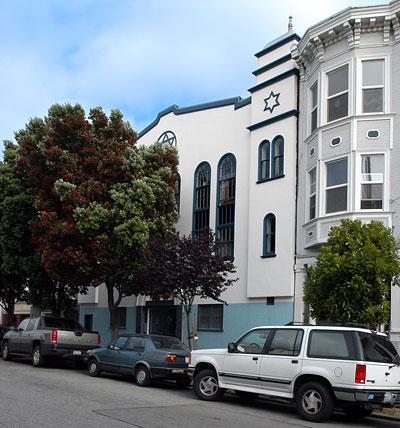San Francisco Landmarks
Congregation B'nai David
3535 19th Street Between Guerrero and Valencia
Built 1908
The following is quoted from Historic Walks in San Francisco: 18 Trails Through the City's Past by Rand Richards:
The Jewish population in San Francisco in the wake of the gold rush was mainly reform (such as Temple Emanu-El and Temple Sherith Israel) and came from many countries.
From about 1880 to 1910 a new wave of Jewish immigrants came to San Francisco from eastern Europe, most of them from Russia, Poland, and Romania. They tended to be Orthodox. They established their own congregation - B'nai David - in the Mission District.
Originally located near 16th and Mission streets, they built this unassuming temple here after the 1906 fire. Stucco and tile over a wood frame, the building typifies what has been called "recessive protective architecture." In other words, it was designed to not call attention to itself, bespeaking an attitude born of centuries of persecution.
Part of the building's historic significance was its mikvah, or ritual bath, which was used for purification purposes. This mikvah was the first one in northern California. Orthodox Jews came from as far as Nevada to use it.
The congregation started to decline in the 1930s as members dispersed. By about 1960 regular synagogue services had ceased [see note], and during the 1970s, the temple closed. The mikvah was moved to Menorah Square, a Jewish retirement home in Pacific Heights. The building was sold, the interior was revamped, and in 1981 it was converted to apartments.
Webmaster note, June 2013:
A Bay Area cantor, whose father was the director of Congregation B'nai David, advised me that services continued regularly throughout the 1960's and 1970's until 1978 when the congregation officially locked up.
